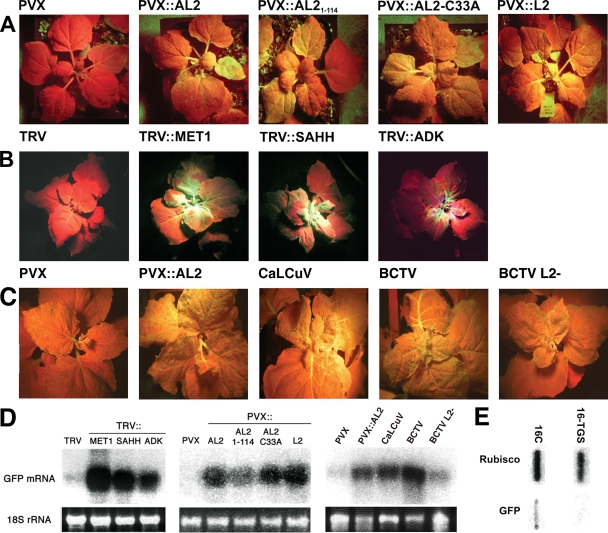FIG. 1.
Overexpression of AL2 and L2, as well as geminivirus infection, reverses TGS of a GFP transgene. (A) Transgenic N. benthamiana plants containing a transcriptionally silenced 35S-GFP transgene (line 16-TGS) were inoculated with PVX vector or PVX expressing the indicated viral protein. Plants were photographed under UV light 2 weeks postinoculation. Uniform dark red color resulting from chlorophyll autofluorescence in the absence of GFP is evident in the PVX-inoculated plant. Release of TGS is indicated by the presence of GFP (yellow-green color) in veins and mesophyll of upper leaves following inoculation with PVX::AL2, AL21-114, AL2-C33A, and L2. Results shown are representative of at least three independent trials with 4 to 8 plants per treatment. (B) As described for panel A except that 16-TGS plants were inoculated with VIGS TRV vector or TRV expressing sequences derived from the indicated endogenous genes in order to reduce their expression. Plants were photographed under UV light 4 weeks postinoculation. (C) Line 16-TGS plants were inoculated with PVX (negative control), PVX::AL2 (positive control), CaLCuV, BCTV, or BCTV L2-2 mutant (L2−) virus. Plants were photographed under UV light three weeks postinoculation. Results shown are representative of two independent trials with 16 plants per treatment. (D) Northern blot of RNA from leaves of 16-TGS plants inoculated as indicated. The 32P-labeled probe was specific for GFP mRNA. The 18S rRNA loading controls were visualized by staining the gel with ethidium bromide. (E) Nuclear run-on analysis indicating GFP transcription in line 16C and transcriptional silencing in derivative line 16-TGS. Rubisco served as a control.

